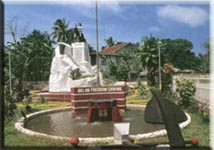Tourist Attractions: Aklan Province Islands Philippines
 Freedom
Shrine Dedicated to the 19 martyrs of Aklan who started the revolt
against Spain. Freedom
Shrine Dedicated to the 19 martyrs of Aklan who started the revolt
against Spain.
Kalantiaw Shrine, Batan. Once the seat of government of Rajah Bendahara
Kalantiaw promulgator of the famous Code of Kalantiaw.
Ingus-Ingus Hill, Buruanga. In Spanish time, it served as a lookout
for approaching Moro pirates that used to maraud coastal villages.
Underneath the hill is a cave, which according to folktales, was
used as an ambuscade of English pirates, buccaneers, and other plunderers
of Spanish galleons carrying precious cargoes.
Agtawagon Hill, Balete. Served as a camp and the last line of defense
of Filipino soldiers and guerillas during World War II.
Museo It Akean, Kalibo. A repository of antiques dug
up in Aklan, which trace the province's rich cultural and historical
past; also houses famous works of arts.
Manduyog Hill And Aklan State College Of Agriculture
(ASCA), Banga. Named after Datu Manduyog, successor of lawgiver
Kalantiaw III. It is 500 feet high with life-size stations of the
cross winding up the hillside and a chapel at the summit overlooking
the countryside. Down the hill is the ASCA, an agricultural institution
spread on 69 hectares. Tropical fruit trees such as rambutan, mangosteen
and lanzones abound in the school campus as well as pastureland
and sprawling ricefields.
Ob-Ob Hill, Bgy. Songcolan, Batan. Stands 200 meters high like a
lighthouse facing the Sibuyan Sea. At its foot of the rocky hill
is a fine beach.
Tinagong Dagat, Batan. "Hidden Sea", approx. 8 kms. long
and 4 kms. wide, between Altavas and Batan, partly hidden from Batan
Bay by two islands, fringed with mangroves, thick undergrowth and
rocky beach.
Tigayon Hill, Kalibo. A solitary mountain of solid rock amidst
stretches of flatlands. One of the sides is a shallow cave with
an arched entrance. Inside is an altar-like rock and two bench-like
rock formations on its side.
page 2... Tourist Attractions: Aklan
Province Islands Philippines
Travel Quotes:
Traveling, you realize that differences are lost: each city takes to resembling all cities, places exchange their form, order, distances, a shapeless dust cloud invades the continents. Italo Calvino
To travel is to discover that everyone is wrong about other countries. Aldous Huxley
Philippine Cuisine Island Philippines
Puchero (beef in bananas and tomato sauce), afritada (chicken and/or pork simmered in a peanut sauce with vegetables), kare-kare (oxtail and vegetables cooked in peanut sauce), pinakbet (kabocha squash, eggplant, beans, okra, and tomato stew flavored with shrimp paste) crispy pata (deep-fried pigs leg), hamonado (pork sweetened in pineapple sauce), sinigang (meat or seafood in sour broth), pancit (noodles), and lumpia (fresh or fried spring rolls).
More details at
Philippine Cuisine Island Philippines Travel with kids, travel prepared
Well, when kids are with you, you need to be more prepared because as we all know they have special needs and we have to respond to such needs. With the tips provided below, it would surely help you get yourself prepared for the entire travel. Travel with kids, travel prepared
|



